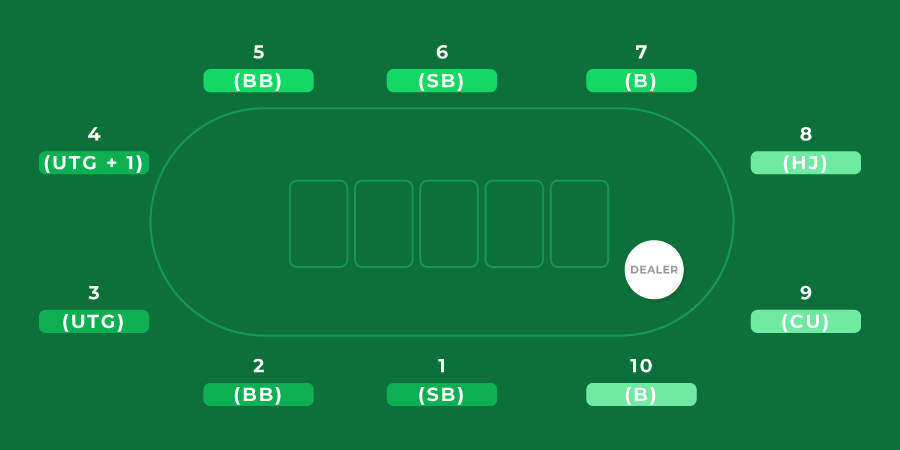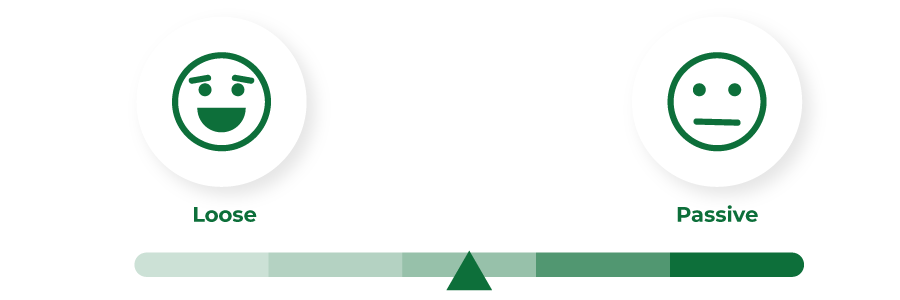Poker instruction is a tricky business. There are so many factors to remember that it can be confusing. With that in mind, we have created a series of bite-sized Poker Cheat Sheets.
These are designed to provide you with simple, easily referenced information you can review, print out, and refer to while playing a game or before a session.
Where we think further elaboration might be helpful, even as you use the poker cheat sheet, we have provided simple links to the information you can read for further education.
Here’s the list of poker cheat sheets you will find below.
Your advantage and profit in poker come from making more money when you win hands and losing less when you lose hands.
To do this, you need to adopt some general play habits. I list them below.
This is no substitute for the thoughtful play of individual hands in individual situations, but these principles should guide your play.
10 Principles of Profitable Poker Play
1. Be Selective

Your first guiding principle should be to be selective in the hands you play. You will not waste money on starting cards that will generally not show a profit. You will fold bad starting cards.
2. Be Aggressive

You want to charge people for drawing against you when you believe you have the better hand and for seeing your final hand. To do this, you need to take the initiative and be the aggressor.
3. Take Advantageous Draws

You want to take good bets when offered and decline bad bets. This means recognizing when your pot odds warrant seeing the next card for the price of a bet and folding when you don’t have the odds to continue your draw.
4. Consider Implied Odds

Figuring out pot odds, and comparing it to the odds of drawing what is likely to be a winning hand, is a necessary but insufficient part of the equation. To be a winning player, you must also consider how much money you may eventually earn after you hit the card you’re drawing for. These are implied odds. You also need to weigh them carefully when deciding on playing a drawing hand.
5. Don’t Fall in Love with Your Hand

You need the discipline to fold hands that looked good initially but are no longer likely to be profitable due to other events since you received them, like the developing board and your opponents' bets in subsequent betting rounds.
6. Situational Awareness

You need to replace habitual play with play that reflects each unique circumstance. Be aware of that exceptional circumstance and tailor your betting action to it.
7. Ranges not Specific Hands

Instead of putting your opponent on a specific hand, consider the range of hands your opponent is likely to have and tailor your betting decisions to that range.
8. Trust Your Reads

Make your read as best you can, and base your betting decision with it in mind. Resist the urge to doubt your read when it points you to a betting action you don’t want to make.
9. Take Breaks

Your brain is your most potent weapon. Take care of it by resting it regularly. Give yourself perspective on the game by providing regular opportunities to reflect.
10. Walk Away When Distracted

Your emotions are your greatest enemies. Don’t let them infect your thoughtful play. Sometimes, events at the table will cause you anxiety, anger, fear, or pain. When you notice these emotions creeping in or seizing control of your behavior, leave the table until they have subsided.

Below, I have created a checklist when you are getting ready to play.
It’s helpful to have a checklist you refer to before you play to ensure you are at your best. Below is the simple cheat sheet of preparation.
Do I want to Play?
The great thing about poker is that you can always decide not to play. Think about how you’re doing and whether you want to play. Are things good at home? No severe stressors interfering with your play? Have enough time for a good session? Not feeling rushed or otherwise pressured? Do you want to play? If so, then great – go ahead and play!
How Long Do I Plan to Play?
It’s helpful to have a plan going into the session. Think about an ideal starting and ending time before you go. And then, if game conditions warrant it, change that plan to fit your new circumstances.
What is the Right Stake for You?
Your bankroll is your weapon. You want to make sure you are adequately armed for battle. This means playing in a game where the stakes are comfortable for you. Again, you may change your plan based on conditions. If, for example, you see a great game of bad players at stake slightly higher than you planned on playing, you might decide to take a shot at it – especially if your preferred game is filled with rocks. But have a plan for what level you’ll be playing.
Bringing Your Best Game
Players have A, B, and C games. A player who consistently brings their A-game to the table will have an advantage over some players with better A games, but who play their B and C games much of the time. You want to do what is required to play your best game all of the time.
Give Yourself Space to Get Mentally Prepared to Play
Having a buffer between your arrival at the poker room and your play is helpful. Take at least a few minutes to get settled, put your brain in competitive mode, and set yourself on winning. Some players have affirmations they think about, and others practice brief meditation. Whatever works for you, insert it between your arrival and your play.
Creature Comfort
Ensure you take care of your physical needs before coming to a game. Bring a jacket or sweater if the room tends to be cold. Make sure to bring snacks or beverages you like, your charging cord, battery pack, phone, tablet, notebook, card protector, etc., that you want when you play. Have a checklist of what you want that you can refer to before you leave for a poker-playing session.
Dispense with Distractions
Get the distractions out of the way before you play. Need to return a call, pay a bill, set a reminder alarm for a meeting, or submit an invoice? Do it before you sit down to play. The less you have to worry about outside of poker when you are playing, the more attention you can devote to the game itself.
Each session should allow you to learn and improve your poker game. For that to be the case, you must have a consistent way of recording and thinking about each playing session. Here’s a simple checklist for recording your sessions so that they will be available for review and analysis later on.
There are apps for this, programs explicitly tailored to poker play, or you can go old school and use a notebook and pen.
- Session Location: Where did you play? List the name of the poker venue and its location.
- Hour: The time the session began. If you changed games, record the time of each.
- Duration: The length of each session
- Cumulative Duration: A running tally of your hours for the year.
- Game Type: What was the game, and what were the stakes? Again, if they changed, record each.
- Win/Loss: How much did you win or lose for your session?
- Cumulative Win/Loss: A running tally of your wins/losses for the year.
- Notes: Add anything that will be useful for future analysis. Opponents? General game type (loose, tight, aggressive, passive), problem hands, your play, etc.

This is a quick summary of the relative advantages and disadvantages of position and how it applies to your strategy in a game. Refer to it to remind yourself of the different positional considerations during gameplay.
- EARLY POSITION: The first four seats in a standard 10-seat poker game are considered EARLY POSITION. This includes the Small Blind and the Big Blind.
- MIDDLE POSITION: The next three seats, seats 5,6 and 7, are considered MIDDLE POSITION.
- LATE POSITION: The last three seats, 8, 9, and 10, are considered LATE POSITION. The position is also referred to in relative terms. If I am the 10 seat and you are the 9 seat, I am said to have position on you. This is also known as having a positional advantage. I would be “in position”; and you would be “out of position.”
- POSITIONAL ADVANTAGE OF LATE POSITION: The player with a relatively later position is said to have a positional advantage. For example, the 7 seat has a positional advantage over the 6 seat, but has a positional disadvantage to players in the 8, 9, or 10 seat. There are many reasons why a later position is advantageous.
Below is a simple list of those advantages:
- You get to see your opponent act first, and use their decision to bet or check to help you determine their strength.
- Your opponent must act before seeing you act, with no betting information to judge your strength.
- You can raise an opponent if they bet.
- You can end the betting action on that round by calling an opponent’s bet.
- You can watch for your opponent’s reaction to the flop, turn, and river before you decide how to bet.
- You can better assume that the pot will not be raised after you call.
- Your opponent cannot necessarily access your reaction to the flop, turn, and river before they decide how to bet.
- When playing against straightforward players, there is less likelihood that your bet will be raised.
- When playing against straightforward players, there is a greater likelihood that you will win the hand with your bet.
- You can more easily execute a “float play” by calling your opponent’s pre-flop bet and then betting on a future betting round if they check with you.
- You can more easily execute a “squeeze” by raising your opponent and a caller.
- You run less risk of having someone raise you if you attempt to steal the blinds by raising.
- You will have a better idea of the eventual size of the pot at the end of the betting round, helping you figure out your pot odds.
There are some disadvantages of late position. I list them here:
- You cannot check-raise your opponent.
- You are more likely to get check-raised
- You are less able to discourage opponents from entering the pot.
There are also considerations for late position that are not necessarily positive or negative:
- Your bet is less likely to be viewed as a value bet.
- Your bet is more likely to be viewed as a bluff.
Finally, here’s a list of matters to consider about your relative position:
- You need a more substantial hand to open the betting in an early position.
- You can expand your range when opening the betting in a late position.
- In general, you can play more loosely from a late position.
- You can generally open up your 3-betting range from a late position.
- Expect your good opponents to raise and 3-betting with a broader range in the late position.
- Expect your good opponents to have stronger hands when they raise or 3-bet in an early position than when they raise or 3-bet in a late position.
Important: Keep it really simple when you start out.
When you start out, it helps to keep things simple – really, really simple. Toward this end, I have assembled a cheat sheet for your play. THIS IS NOT AN OPTIMAL STRATEGY FOR EXPERIENCED PLAYERS! You can’t play winning no-limit hold’em or any other poker game just by following a simple chart.
You will eventually discard this cheat sheet as you learn more about the game and your opponents. But, when you are starting, it should help you keep out of trouble as you observe and learn the game.
In the parlance of modern poker theory, when you start, you will adopt a very narrow range of playable hands; you will generally raise with them if the pot has not already been raised. I have highlighted the hands that you should 3-bet with if the pot has already been raised when it comes to you.
The amount of your raise or 3-bet should be the same, no matter what hand you have.
In general, in the low blind, capped buy-in no limit game that you will tend to be in when you are learning, keep it to a raise of 3 times the BB. So, for example, in a $1/2 game, make it $8 to go ($2 plus 3 x $2). If everyone else raises to a larger number, they tend to make it what others do. If, for example, at your table, players tend to raise the $2 to $6 or $10 or $12, you do that too. Also, if others have already called the big blind, add a big blind for each caller to your raise.
So, if three people have already called the $2 big blind, make your raise to $14 (You are raising the $2 big blind by: 3 x $2 ($6) plus $2 for each of 3 players who called ($6).)
A 3-bet is a raise of a raiser. In general, you should raise the raiser to three times his bet. So in a $1/2 game, for example, if the initial raiser made it $8, and you have one of the 3-betting hands, you should make it $24.
This chart adjusts your hands and how you play them based on your position.
As you gain experience, learn to read your opponents, and figure out the general style of play of the players at your table, you will adjust these raising standards.
In the cheat sheet below, I group hands by your position relative to the dealer. I start with early position, then cover the middle position, and finally late position. I identify the specific hands with which you should raise the big blind and re-raise (also known as a 3-bet) if someone else raises.
I then list the hands you should call with. (You’ll notice that in the early position, I list no calling hands – as I recommend, in this rudimentary tight-aggressive strategy, that you either raise or fold). Re-raising hands are in bold.
Early Position (Seats 1, 2, 3, and 4)
| Raising and Re-raising (3-betting) |
| A A |
| K K |
| Q Q |
| J J |
| A Ks |
These are hands you raise with (typically by 3 x BB), in an unraised hand, in early position.
If the hand has already been raised when it comes to you, 3-bet (typically to 3 x the raised amount) with the hands that are in bold, and just call the raise with the other hands.
Calling Hands: None
Fold all other holdings in early position.
MIDDLE POSITION (Seats 5, 6, or 7)
| Raising Hands (and 3-betting) |
| A A |
| K K |
| Q Q |
| J J |
| T T |
| A K |
| A Qs |
| A Js |
| CALLING HANDS (Call the big blind with the following hands if the pot has not been raised) |
| All pairs lower than TT |
| A Ts |
| A Q |
| A J |
| A T |
Fold all other hands.
LATE POSITION (Seats 8, 9, 10)
| RAISING HANDS (and 3-Betting) |
| A A |
| K K |
| Q Q |
| J J |
| T T |
| 9 9 |
| A K |
| A Qs |
| A Js |
| A Q |
| A J |
| A T |
| K Qs |
| CALLING HANDS |
| All other pairs (8 8 and lower) |
| All suited Aces (A-9 and lower) |
| All “Broadway” hands (KQ, KJ, KT, QJ, QT, JT suited and unsuited) |
Fold all other hands.
Adjustments based on player type, stack size, image, and general characteristics of the game you’re in.
As dictated by the general strategy cheat sheet, a strictly mechanical playing style is likely to be unsuccessful in the long run, as opponents figure you out and take countermeasures. You may win some small money, even as you are largely inactive. But you’ll miss out on many profit opportunities, as you’ll be playing very few hands. Also, playing strictly in this style will make you obvious to the better and more experienced players. To them, it will be like you are playing with your cards exposed.
They’ll eventually figure this out and bluff you mercilessly while avoiding you when you are powerful.
By playing in the rigid and mechanical style that any prescribing cheat sheet requires, you won’t win as much as you would if you took advantage of the many profitable opportunities offered by poor, mediocre, and otherwise mistake-ridden opponents. In the games, you should be seeking out, with many poor, inexperienced, and otherwise exploitable opponents, the majority of your profit will come from exploiting the many errors made by your opponents – not your expert play.
So you’ll want to open up your range considerably to allow you to exploit your opponents’ errors.
This cheat sheet gives you a general way of responding to common errors and situations that present themselves to you in a typical, error-ridden game. Find the characteristic that describes the game and the opponent, then make the suggested adjustments.

Let’s explore the different types of players and how you should deal with them:
Loose-Passive Opponents

These players, also known as “calling stations,” are ideal opponents for you. They will tend to stay in even when you bet and raise. Punish them! Against them, you are best to bet your medium strong and stronger hands aggressively, giving them no discounts as they try to draw out on you.
You should also respect their raises more, as they tend to limp rather than raise. When a game is filled with them, and players tend to limp in for the big blind, you can also expand your range, limping in for many hands that you would usually fold.
Tight-Passive Opponents

These are the nits and the rocks who rarely give any action, waiting until they have the strongest quality hands to bet; and not continuing to bet unless they improve. Simply put, when they bet, they have it. They may even brag about this, announcing proudly that they never bluff. Against them, the play is simple.
Unless you have a super-strong hand, don’t play. Give them no action. DON’T FEED THE NITS!
Loose-Aggressive Opponents (LAGs)

LAGs will raise with a very broad range, especially from a late position. In an unraised pot, they may raise with any suited connectors, including one and two gappers like Th 8h, 9s 6s, 4c 3c, not to mention Broadway cards and any Ace hand. Generally, when you play these types of opponents, you want to play them in position.
That is to say that you want to have position on them for all future betting rounds. If they are in the 5 seat, you want to be in the 6,7,8,9 or 10 seat. If they are in the 9-seat, you want to play against them only from the button.
This is for two reasons. You want to take advantage of their very broad range when you have medium strength or stronger hands when you see how they play the flop, taking advantage of any perceived weakness on their part. You want to see if the flop significantly improves your hand, so you can confidently call off their frequent bluff and overplaying action when you have improved.
Tight-Aggressive Opponents (TAGs)

TAGs are players who tend to be very selective in their hands and who play those hands aggressively. When they raise, especially in early or middle position, they tend to have a solid hand. They tend to fold hands that aren’t very strong, especially from early and middle position.
It is surely better to have position on a TAG. But, because they play so few hands, you’re not too worried about their position on you. You’re also playing a very tight game, so you will not be in the same hand very often.
You want to proceed cautiously when a TAG raises or 3-bets. Assume they have the hand they represent, and get out of the way, unless you are powerful.
One exception that you can try occasionally is to re-raise them as a bluff if they have raised in a late position, even if your hand is only medium strength. Being risk averse and having raised in a late position when their range is likely to be at its broadest, they may well fold to your unexpected and unusual 3-bet, afraid that they are behind.
Adjustment for Loose-Passive Game
Just as you can adjust your typical range to exploit different types of players, so too can you adapt your range for a particular type of game – the loose-passive game.
Sometimes, your game will be filled with poor, mediocre, and recreational players. These players are there to have fun or haven’t yet learned to be solid players. Since they’re trying to have fun and think having fun is playing, they tend to play many hands. But being inexperienced and unskilled, they typically don’t raise much. This game has a lot of calling and not a lot of raising.
Pre-flop, there may often be no raise, with four or more people frequently seeing the flop for just the price of the big blind.
When this is the case, you can broaden your calling range, limping with more hands, regardless of your position. Specifically, when you are in the middle or early position, you can call the big blind with all of the hands you would play from the late position since there is a relatively low chance that the pot will be raised after you enter it. You should make a few other adjustments, as I indicate below.
It may be helpful for you to have a cheat sheet to remind you of your drawing odds. These are the odds against you making your drawing hand.
The left column lists the hand you are drawing with. The second column lists the odds against you making that hand with one card to come. The second column lists the odds of making it with two cards to come. Looked at differently, the second column lists the odds against you making it by the turn.
The last column lists the odds against you making the hand by the river. I’ve also converted the odds into a percentage, so you can quickly see what percentage of the time you will likely make your hand – with one and two cards to come.
I’ve also created a cheat sheet showing how many outs you have in different situations.
I’ve thrown in a cheat sheet explaining the super-easy shortcut you can use as situations arise.
| Odds Against Making A Hand The Hand | By Turn One Card to Come | By River Two Cards to Come |
| Flush draw | 4.2 to 1 / 19% | 1.9 to 1 / 35% |
| Straight draw (open ended) | 4.9 to 1 / 17% | 2.2 to 1 / 32% |
| Straight draw (gut shot) | 11 to 1 / 9% | 5.2 to 1 / 17% |
| Full house draw (two-pair) | 11 to 1 / 9% | 5.2 to 1 / 17% |
| Full house draw (trips) | 5.7 to 1 / 15% | 2 to 1 / 33% |
| Two overcards making top pair | 6.8 to 1 / 13% | 3.2 to 1 / 24% |
You should eventually be able to memorize this information, so you won’t even need to refer to a cheat sheet. But it also helps to have this for quick reference.
Here’s another chart for determining how many outs you have with different draws.
How Many Outs Do You Have?
- Flush draw: 9 outs;
- Straight Draw (gut shot): 4 outs;
- Straight Draw (open ended): 8 outs;
- Flush and straight draw (gut shot): 12 outs;
- Flush and straight draw (open ended): 15 outs;
- Full house draw (two pair): 4 outs;
- Full house (or better) draw (trips): 10 outs;
- Two over cards making top pair: 6 outs.
Outs to Odds Shortcut
Situations during the play of a hand will require you to figure out your drawing odds. If, for example, you believe you will win if you either draw a top pair or make your flush, you have a combo draw. Combo draws are harder to calculate on the fly because you have to do a couple of computations and then add up the results.
Rather than do that math in your head, or have to memorize even more figures than the one above, there is a simple shortcut that you can do to get results that are roughly the same as the results above. It’s called the four and two methods.
Simply put, you take the number of outs you have to make your hand. You then multiply this by 2 if you need to make your hand with only one card to come or 4 if you have two shots to make your hand.
For example, if you’re on the flop and want to know the odds against you making your hand on the turn, and you have 5 outs, you would multiply 5 by 2 and get 10.
You would have roughly a 10% chance of making your hand on the turn. If you wanted to know the chances of making your hand by the river, you’d multiply by 4. You’d have a 20% chance of making your hand.
Final Thoughts
These Poker Cheat Sheets are your ultimate companions to help you navigate the complex world of poker with ease and eventually becoming a full-time player (if that's your goal, of course).
Designed to be concise and easily accessible, they provide you with essential information on poker strategy, preparation, record-keeping, position, pre-flop range, exploiting different player types, and odds and outs.
While these cheat sheets offer a solid foundation, remember that they are just the starting point. As you gain experience and develop your skills, you'll find yourself deviating from these guidelines to adapt to specific game dynamics.
So, grab your cheat sheets, keep them handy, and get ready to up your poker game to new heights!
And remember, you can always check my other guides in the Poker Academy to discover new gameplay strategies.

Bonuses
Casinos
Games
Academy
News
Shop
NEW Q&A
Sweepstakes




































